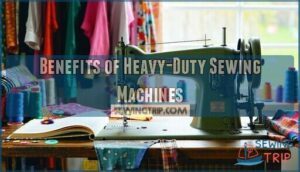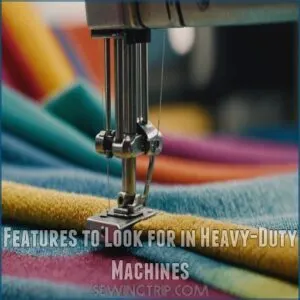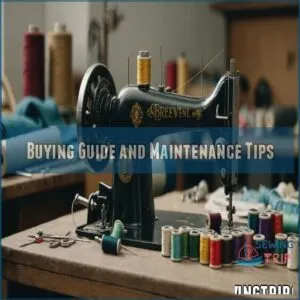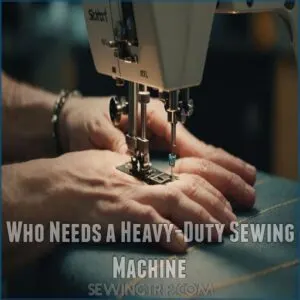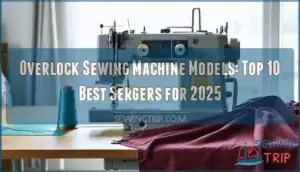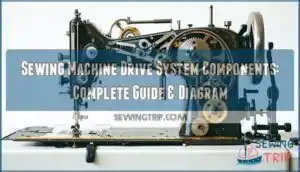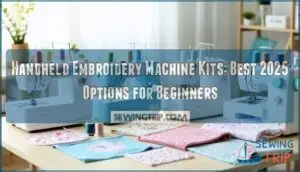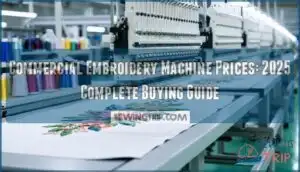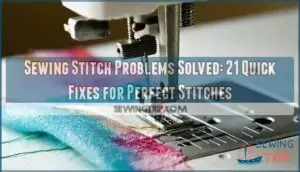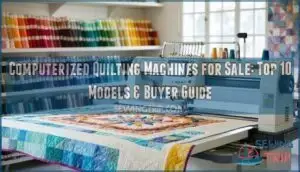This site is supported by our readers. We may earn a commission, at no cost to you, if you purchase through links.
 Looking for the best heavy duty sewing machine reviewed?
Looking for the best heavy duty sewing machine reviewed?
Imagine this: you’re tackling denim, leather, or even thick quilts, and you need a machine that won’t quit on you.
Consider the Janome HD3000, known for its balance of power and versatility, or the Singer 4423, celebrated for its speed and durability.
If you’re a quilting enthusiast, the Brother PQ1500SL might be your cup of tea with its speed and precision.
These machines boast powerful motors, durable construction, and advanced features like automatic needle threaders and a range of stitches.
Ready to take your sewing to the next level?
There’s more to explore!
Table Of Contents
Key Takeaways
- You’ll appreciate the power and versatility of heavy-duty sewing machines like the Janome HD3000, Singer 4423, and Brother PQ1500SL for tackling tough fabrics such as denim and leather.
- These machines are built to last with durable construction, featuring powerful motors, high speeds, and advanced options like automatic needle threaders and a range of stitches.
- When choosing a heavy-duty sewing machine, focus on features like metal components, high-lifting pressure feet, and a variety of built-in stitches to suit your sewing needs.
- When shopping for a heavy-duty sewing machine, consider the benefits of a metal interior frame, such as those found in best all metal sewing machine, which can provide durability and longevity. Regular maintenance, including cleaning and oiling, is essential to ensure long-lasting performance and reliability from your heavy-duty sewing machine.
Benefits of Heavy-Duty Sewing Machines
When you choose a heavy-duty sewing machine, you gain access to powerful motors and high speeds, allowing you to tackle thick fabrics and multiple layers with ease.
These machines are built for durability and feature advanced options that enhance your sewing experience, making them a worthwhile investment for any serious sewist.
Powerful Motors and High Speeds
Imagine tackling those challenging projects with ease, thanks to the powerful motors and high speeds of heavy-duty sewing machines.
These machines, designed for high performance, offer incredible sewing speed, efficiently handling various fabric types and needle sizes.
Whether you’re working on tough denim or intricate stitch options, the robust motor power guarantees smooth, uninterrupted sewing across diverse project types.
Durable Construction and Long-Lasting Performance
You’ve experienced the rush of a heavy-duty machine’s high speed. Now, consider its backbone: durable construction guarantees long-lasting performance.
These machines rely on quality materials and rigorous design, promising:
- A lifespan extending decades with proper care.
- Solid frame reducing vibration.
- Cost-effectiveness over time despite initial investment.
- Reliability to handle frequent projects without breaking a sweat.
Versatility in Sewing Thick Fabrics and Multiple Layers
Several layers of denim? No problem.
A heavy-duty sewing machine conquers thick fabrics and multiple layers with ease, making it perfect for shopping for heavy-duty sewing needs.
You’ll breeze through leather sewing, denim projects, and upholstery work.
Quilt layers become manageable, even with varying fabric weight.
These machines are built to handle the toughest jobs, giving you the control and mastery you crave.
Say goodbye to frustrating fabric limitations.
Advanced Features for Enhanced Sewing Experience
Switching gears from managing thick layers, imagine leveraging advanced features that redefine sewing ease.
Imagine this: automatic needle threader saving your eyesight, adjustable speed giving you control, and diverse stitch selection making creativity endless.
Consider adding these to your toolkit, such as a sturdy metal frame that provides rock-solid stability, which you can learn more about in advanced sewing machines features.
- Free arm sewing for cuffs.
- Walking foot for precision.
- Invisible zip foot for sleek finishes.
Features to Look for in Heavy-Duty Machines
When choosing a heavy-duty sewing machine, you’ll want to focus on key features like metal components and a robust design to guarantee durability and reliable performance.
Look for high lifting pressure feet, automatic needle threaders, and a variety of built-in stitches that add both functionality and decorative options to your projects.
Metal Components and Robust Design
Durability matters when tackling heavyweight fabrics, and that’s where a metal frame shines.
When considering the best heavy-duty sewing machine for your business, look for an industrial sewing machine guide to ensure you choose a model that can efficiently handle heavy-duty fabrics. In the best heavy-duty sewing machine reviewed, a robust design guarantees strength and long-lasting performance.
You can find a wide range of options for these machines at best sewing machine stores.
You’ll find these machines withstand intense sessions without a hitch.
With solid construction, sewing becomes a breeze, letting you focus on creating rather than worrying about breakdowns.
High Lifting Pressure Feet and Automatic Needle Threaders
When it comes to handling thick fabrics, key features such as needle size for thick fabrics are crucial, and you’ll find high lifting pressure feet and automatic needle threaders in the best heavy duty sewing machines indispensable.
These essential features grant ease when sewing thick fabrics, preventing jams and skip stitches.
An automatic needle threader saves time and frustration. Imagine wrestling with threading? Not anymore! Simplify with these critical must-haves.
Long Warranties and Reliable Performance
Considering a heavy-duty sewing machine? Look for long warranties—your safety net against repair costs.
Reliable performance is key, ensuring longevity and smooth operations with brands like Brother ST371HD and Juki TL-2010Q.
Here’s what to keep in mind:
- Warranty Length: Supports long-term use.
- Machine Lifespan: Extended and durable.
- Brand Reliability: Trustworthy options like Singer Heavy Duty 4452.
Variety of Built-in Stitches and Decorative Options
So, you’ve got a reliable machine with a great warranty. Now, let’s talk stitches! A wide variety of built-in stitches is key. You want options, right?
Check out these stitch capabilities:
| Stitch Type | Description | Example Use Cases |
|---|---|---|
| Straight Stitch | Basic stitch for seams and straight lines. | Everyday sewing, hems, seams |
| Zigzag Stitch | Versatile stitch for finishing edges. | Prevents fraying, decorative edging |
| Decorative Stitches | Adds flair to your projects. | Monograms, embellishments, custom stitch patterns |
| Buttonhole Stitch | Creates buttonholes. | Clothing, crafts |
More stitches mean more creative freedom!
Buying Guide and Maintenance Tips
When you’re selecting the right heavy-duty sewing machine, pay attention to features like sturdy metal components and reliable built-in stitches that match your sewing needs.
To keep your machine in top shape, regular cleaning, oiling, and a proper maintenance schedule will guarantee smooth operation and longevity.
Choosing The Right Heavy-Duty Sewing Machine
Choosing the right heavy-duty sewing machine means focusing on your sewing needs, budget, and brand comparison.
Consider the power of a Singer Heavy Duty sewing machine for thick fabrics, featuring a powerful motor for heavy fabrics, and consider machine features like sewing speed and weight, and evaluate models such as the Janome HD5000 and Janome HD1000.
Pay attention to warranty and support options available.
These elements make sure the machine fits your projects, providing reliability and efficient performance.
Cleaning and Oiling The Machine
You’ve picked the right machine, now let’s keep it humming smoothly.
Grab your cleaning supplies and tackle lint with a quick brush.
Don’t forget oiling frequency: a few drops at lubrication points like the needle bar works wonders.
Whether you’re a DIY hero or call in a professional, regular sewing machine maintenance is your ticket to hassle-free stitching adventures.
Servicing and Maintenance Schedule
Regular maintenance keeps your machine humming smoothly.
You’ll want to service your best sewing machine annually to prevent common problems.
Don’t wait until issues arise.
Here’s a quick guide:
- Check lubrication tips: Lube every three months.
- Inspect needle sizes: Match them to fabrics, especially when sewing leather.
- Embrace preventative care: Tighten screws, avoid blind hems mishaps.
Troubleshooting Common Issues and Repairing The Machine
Switching gears from keeping your machine sharp, let’s tackle common hiccups like needle breakage, thread jams, and motor problems.
Understanding these issues, especially with models like the Singer 14hd854, Janome HD3000, or Brother PQ1500SL, helps keep sewing smooth.
When searching for the right equipment, consider exploring online marketplaces for Heavy Duty Industrial Machines.
| Issue | Solution | Model Examples |
|---|---|---|
| Needle Breakage | Use appropriate needle size | Janome HD3000 |
| Thread Jams | Rethread and check tension settings | Brother PQ1500SL |
| Motor Problems | Inspect motor and connections | Singer 14hd854 |
Who Needs a Heavy-Duty Sewing Machine
If you’re a professional tailor or dressmaker tackling large quantities and tough fabrics, a heavy-duty sewing machine is essential for your craft.
Home sewers and quilters will also appreciate the reliability and durability offered by these machines, making them great for anyone needing a sturdy, high-performance tool for their sewing projects.
Professional Tailors and Dressmakers
So, you’ve mastered machine upkeep; now let’s talk tailoring techniques.
Professional tailors and dressmakers need heavy-duty machines for their demanding work, often opting for top-rated models like the Janome HD3000 Heavy Duty Sewing Machine.
Think about the constant pressure of custom fitting and the variety of fabrics—from delicate silks to sturdy wools.
A heavy-duty machine provides consistent, high-quality stitches, which are essential for dressmaking trends and professional standards.
It’s an investment in your craft, giving you the control and freedom to create stunning garments.
Proper machine upkeep is key to maximizing its lifespan.
Home Sewers and Quilters
After hours at the design table, home sewers and quilters crave reliability.
You’re creating a masterpiece, from intricate quilting techniques to bold project ideas on varied fabric types.
A heavy-duty sewing machine becomes your steadfast partner, handling multiple layers and diverse sewing accessories with ease.
Regular machine care guarantees your creative journey is smooth, letting your imagination soar.
Anyone Who Wants a Reliable and Durable Machine
When it comes to sewing, if you’re seeking a reliable and durable partner, heavy-duty machines are your go-to.
Top brands promise long machine lifespan, minimizing repair options through robust builds and detailed warranty information.
Cost comparison shows their value in longevity, effortlessly handling tasks standard machines might shy away from.
They’re built to endure, providing assurance with every stitch.
Frequently Asked Questions (FAQs)
What is the best heavy duty sewing machine?
When choosing the best heavy-duty sewing machine, consider the Janome HD1000 for its durability and performance.
It balances affordability with the power to handle tough fabrics.
With 14 built-in stitches and a solid cast aluminum body, it is a great choice for those looking for a durable and reliable machine.
Should you buy a heavy-duty sewing machine?
Picture tackling a sewing project with ease.
Heavy-duty machines handle thick fabrics and multiple layers effortlessly, perfect for challenging tasks.
If you regularly sew tough materials, investing in a heavy-duty model can be a wise choice.
What is a heavy-duty sewing machine?
It’s a powerful sewing machine built to handle tough fabrics like denim and leather. You’ll appreciate its durability and speed, perfect for tackling challenging projects with ease and precision.
Which sewing machine is right for You?
Think of choosing a sewing machine like picking a trusty horse for the journey ahead.
Assess your sewing needs, fabric types, and project frequency.
Then explore features like power, stitches, and durability to find your perfect match.
How do heavy-duty sewing machines differ from industrial models?
When choosing the best sewing machine for thick fabrics, consider a machine with a metal frame, sturdy sewing bed, and reliable feed dog system, such as those described in Thick Fabric Sewing Guides. Heavy-duty sewing machines handle thick fabrics and home projects, perfect for frequent use.
Industrial models, however, are built for speed and efficiency in factories, running continuously for long hours, sewing at higher speeds, and tougher materials.
What is the weight of typical heavy-duty machines?
Imagine this: you’re wrestling with a behemoth as hefty as a small dog.
Most heavy-duty sewing machines weigh between 15 to 25 kilograms, providing stability for sewing thick fabrics without skittering across your table.
Are heavy-duty sewing machines noisy during operation?
Yes, heavy-duty sewing machines can be noisier than regular machines due to their powerful motors.
However, many models incorporate features to reduce noise, making them reasonably quiet for home use.
Maintenance helps minimize operational noise.
Can these machines handle intricate decorative stitches?
These machines can tackle intricate decorative stitches, thanks to their powerful motors and advanced features.
You’ll find them ideal for creating detailed designs, while their robustness guarantees precise stitching, making your projects both stylish and resilient.
What accessories are essential for heavy-duty sewing machines?
You’ll find owning the right accessories important for heavy-duty sewing machines.
Trust me, having heavy-duty needles, walking foot, sturdy bobbin, extra spool pin, quality thread, and specialized feet like zipper or buttonhole foot makes a difference.
Conclusion
Ultimately, choosing the best heavy duty sewing machine reviewed depends on your specific needs.
Consider your budget and the types of fabrics you’ll sew most often.
Do you need high speed for quilting, or robust power for leather?
To ensure smooth operation, consider the thread weight and needle size, for instance using a topstitch needle like 90/14 or 100/16 for 12wt threads as explained in sewing with heavy duty thread, even the best heavy duty sewing machine requires regular maintenance.
Proper cleaning and oiling will extend its lifespan considerably.
Explore our top picks – the Janome HD3000, Singer 4423, and Brother PQ1500SL – to find the perfect fit for your sewing projects.
Investing in a quality heavy duty sewing machine is an investment in your craft, providing years of reliable service.
Happy sewing!
- https://sewinginsight.com/best/best-heavy-duty-sewing-machines/
- https://sewingfromhome.com/best/heavy-duty-sewing-machine/
- https://www.usnews.com/360-reviews/home-goods/best-sewing-machines
- https://www.hgtv.com/shopping/product-reviews/best-sewing-machines
- https://www.sewingmag.org/best-heavy-duty-sewing-machine-reviews/

